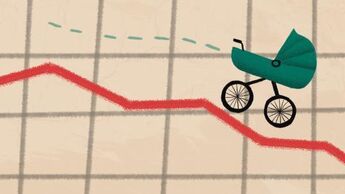
Last week the Office for National Statistics published the latest stats on birth rates in England and Wales. Their findings show that in 2018 the total fertility rate fell from 1.76 to 1.70 children per woman, a drop of almost 10% since 2012.
When births are measured as a proportion of the total population, there was a decrease from 11.6 to 11.1 live births per 1,000 women, which is the lowest rate since records began in 1938.
Excluding stillbirths and miscarriages, out of a total of 862,371 pregnancies there were 657,076 live births, a decrease of 22,030 from 2017. Out of these pregnancies, there were 205,295 abortions. This accounts for 23.8% of pregnancies, leading to a ratio of one baby being aborted for every three that are born.
This was the second highest year in terms of the proportion of abortions to live births since 1969, which is the year records became available. In contrast, in 1969 6.4% of pregnancies ended in abortion meaning there has been a 270% increase in pregnancies ending in abortion since 1969 in England and Wales.
When compared to Northern Ireland, 4.7% of pregnancies ended in abortion (including women who travelled for an abortion) which is a ratio of one baby aborted for every nineteen that are born.
This palpably demonstrates the life-affirming law currently in place in NI until the 21st October, unless the Executive is restored and is able to stop abortion law change being imposed on NI from Westminster.
Behind the stats
The reasons for falling birth rates, and increased abortion numbers, need to be given due attention because they undoubtedly have a substantial impact on our population. Clear patterns have not yet emerged, but there is some evidence to suggest that economic pressures are leading women to feel little other option is open to them. Policies such as the Government’s two-child benefit cap appears to be leading some women to resort to abortion.
But it also seems that many are choosing not to have children. In recent years, there has been a growing proportion of those at child-bearing age who view childrearing as inherently negative, think motherhood is a ‘patriarchal construct’, and encourage mothers to speak of their ‘maternal regret’ following the birth of their children.
Frank Furedi, writing for Spiked, comments on this trend: “There is now a misanthropic ideology that promotes hostility towards those who choose to have children, alongside a growing tendency to paint motherhood in a negative light.”
Furedi points out that finances alone cannot be responsible for falling birth rates because in many societies the decision not to have children is also being made by those who are financially well-off.
Instead, he suggests that young people have been coached to be “aware of their vulnerability”, meaning they are distracted from taking on responsibility: “The very idea of adults assuming responsibility for younger generations is regarded as an outdated custom, at odds with the lifestyles of busy and successful individuals.”
This movement also believes having children is irresponsible because babies “constitute a threat to the environment.” A proponent of such a view is HRH Prince Harry, who recently said that he is only going to have a maximum of two children for environmental reasons. His statements seem to be part of a new norm where people are concerned about the carbon footprint left by having more than two children, or having any children for that matter.
Long term impact of decline
But what so often seems to be missed is the simple fact that a stable birth rate is needed in order to create a balanced social order. In order for a society to sustain itself, the birth rate needs to be around 2.1 children per woman. Demographic inequality leads to lower GDP, an increasing burden on public services, and a shortage of people to care for the elderly, as the aging population grows disproportionately larger than the younger population. Countries like Japan are already facing this dilemma – there are higher sales of adult nappies than baby nappies in Japanese supermarkets.
Campaigns that will undoubtedly increase abortion rates, do not lead to a flourishing society. But this is not just about having policies that will enable effective population control. The problem really lies with our culture’s devaluing of human lives from conception to the end of life. Lives are seen as disposable. Perhaps Furedi is on to something when he comments that the main driver in falling birth rates is not financial or environmental, but it is “the difficulty that sections of society have in giving meaning to life today.”


Share story
The birth rate is now the lowest since records began: what’s behind this trend?